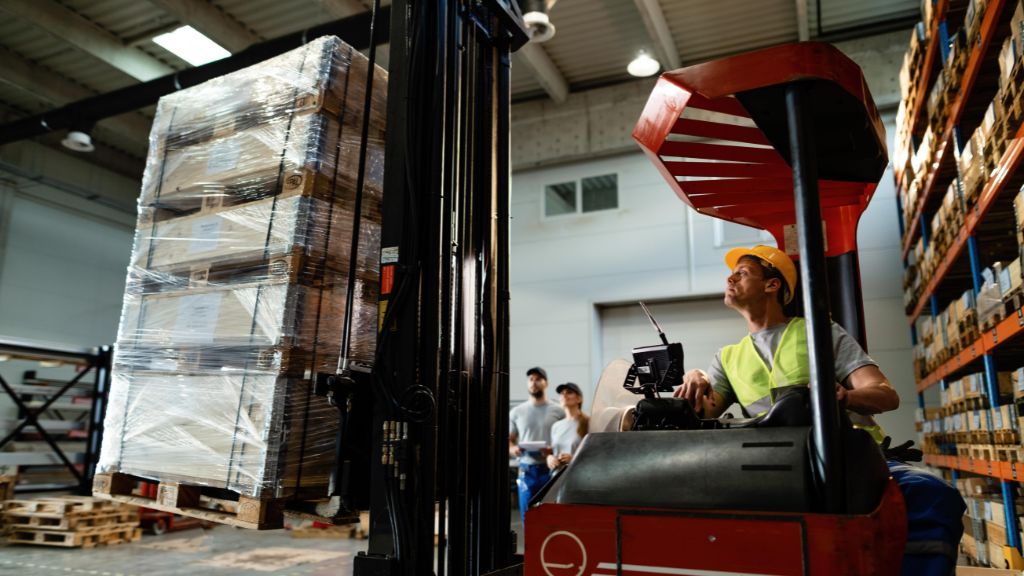Forklift: What It Does and How It Helps
Contents

Amidst the essential logistics equipment for managing warehouses and production industries, one indispensable tool is the Forklift. This versatile machine enhances staff efficiency, cuts costs, and improves workplace safety.
In this article, UPR Thailand introduces what a “Forklift” is, the various types available, and how it’s beneficial across multiple industries.
What is a Forklift?
A forklift is an industrial vehicle designed to lift and transport heavy materials like pallets or product boxes, over short distances, especially in warehouses, factories, and industrial areas. Forklift feature prongs (forks) extending from the front, designed to slide under pallets or goods for lifting.Forklift operates using different power sources, such as diesel engines, LPG gas, or electric batteries, depending on the type and usage. Typically, they can lift from 1 ton to over 50 tons, depending on the design and center of gravity. This makes forklift highly flexible in handling large, heavy materials in warehouses.
Forklift is essential in various industries such as:
- Warehouses and Distribution Centers – for storing and moving goods on pallet racks
- Factories – for moving raw materials and finished products
- Ports and Airports – for loading and unloading goods from containers
- Construction – for moving large building materials
- Large Retail Businesses – for managing stock in storage and warehouse areas
- Agriculture – for moving goods like fruits and crops in warehouses or open spaces
Key Forklift Components
Forklift comes in various types with different spare parts. However, some key components are essential to all forklifts:
- Chassis – the main structure that supports all other parts, including the wheels, cabin, and forks. The size of the chassis varies according to the type of operation and the weight it can handle.
- Mast – the vertical structure that connects the fork assembly to the vehicle and serves as a guide rail for raising and lowering the forks.
- Fork Assembly – attached to the chassis, it secures the forks, allowing them to be raised and lowered easily.
- Counterweight – located at the rear of the forklift, this weight offsets the load being lifted, ensuring stability and preventing tipping.
- Engine and Battery – critical components affecting the vehicle’s operation, available in gasoline, diesel, or electric-powered systems.
Types of Forklift

For indoor warehouse use or pallet management system operations, forklift is categorized into two main types: Internal Combustion Engine Forklift and Electric Forklift.
1. Internal Combustion Engine Forklift
This type of forklift uses internal combustion engines that rely on fuel sources like gasoline, diesel, or LPG. They are ideal for outdoor or open-air environments with adequate ventilation. Their main advantage is their ability to lift heavy loads efficiently, and refueling is quick, allowing for continuous operation.
2. Electric Forklift
Electric forklift is powered by batteries, eliminating the need for costly fuel, offering more safety than combustion engines, and being environmentally friendly. They are perfect for indoor use in warehouses. Electric forklift batteries come in two types: Lithium-ion and Lead Acid, each with its pros and cons.
Forklift can also be classified by usage, with several specialized types, such as:
- Sit-down Forklift – ideal for unloading pallets from trucks, commonly used in warehouses.
- Side Loader – designed for tight spaces, often used in industries like steel, wood, or aluminum manufacturing.
- Rough Terrain Forklift – suitable for outdoor use in rough or uneven areas, such as construction sites, due to their large, durable tires.
- Telehandler – equipped with extendable arms and booms, this type of forklift can reach high or distant loads, perfect for large warehouses or construction projects.
Forklift Benefits in Logistics

Given their widespread use across various industries, forklift offers several key benefits that enhance business operations in multiple ways:
Increased Efficiency
Forklift can move goods much faster than manual labor, saving time and boosting productivity. For example, while it may take 4-5 workers to move a 1-ton pallet, a forklift can complete the task in minutes. Forklift also operates longer without fatigue, ensuring continuous and efficient warehouse operations.
Long-term Cost Savings
Although purchasing or renting forklift involves high initial costs, they save money over time by reducing the need for many workers, cutting training costs, and lowering the expenses associated with lifting-related injuries. Increased efficiency also helps businesses handle higher workloads without additional labor costs.
Improved Workplace Safety
Forklift reduces the risk of heavy lifting injuries, which are a common cause of warehouse and factory accidents. Using forklift instead of manual labor prevents back and joint injuries. Additionally, forklift minimize accidents caused by dropped heavy goods, allowing employees to work safely and efficiently.
Efficient Use of Warehouse Space
Forklift can lift goods to high pallet racks, optimizing vertical storage space and increasing warehouse capacity without expanding floor space. Vertical storage also improves stock management by making goods more visible and accessible, reducing time spent searching and retrieving items.
Support for Pallet Management Systems
Forklift works efficiently with pallet racking systems, aiding in inventory management. When used with a Warehouse Management System (WMS), forklift enhances tracking and positioning accuracy, streamlining inventory processes and improving stock management.
Reduced Product Damage
Forklift minimizes the risk of product damage during handling, as they offer more stability and precision than manual labor. This is especially important when handling heavy or large products, which can be easily damaged by human error during long shifts.
Increased Operational Flexibility
Forklift can be fitted with various attachments to accommodate diverse tasks, such as clamps for lifting oddly shaped or round materials, side shifters for pallet management in tight spaces, or rotators for emptying containers. This flexibility allows businesses to handle a wide range of products using a single machine, reducing the need for specialized equipment.
Enhanced Business Competitiveness
Using forklift helps businesses manage higher workloads, respond to customer needs more quickly, and be more flexible in handling products. This leads to greater competitiveness, allowing companies to take on more diverse projects and expand their operations.
Conclusion
Forklift is a vital logistics tool for managing warehouses and logistics systems. Their ability to lift and move large, heavy goods boosts efficiency, reduces costs, and enhances safety. This enables businesses to manage logistics systems effectively and meet the challenges of a competitive market.
For warehouse operators or businesses with their own warehouses, UPR (Thailand) Co., Ltd. offers a full range of logistics equipment, including rental/purchase options for wooden and plastic pallets, pallet racks, and various storage solutions. We also provide advanced logistics solutions that integrate seamlessly with forklift.
We are ready to provide fast, comprehensive, and professional service with over 10 years of experience in Thailand.
Contact Us
Fill out the form: www.upr-thailand.co.th/en/contact/inquiries/
Tel: +66-2-672-5100
Email: info-thailand@upr-net.co.jp
UPR (Thailand) Co.,Ltd. > Columns > logistics > Forklift: What It Does and How It Helps

 Contact us
Contact us  Call us
Call us  Line Official
Line Official